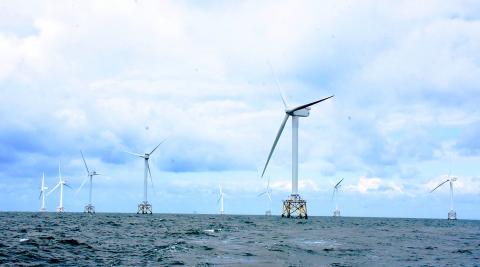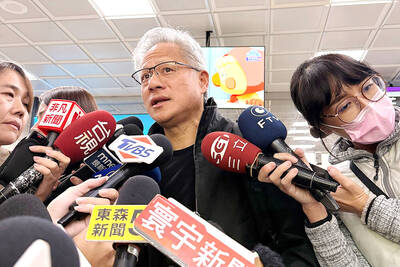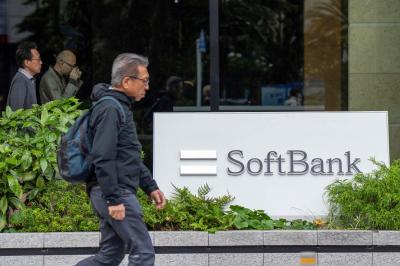Changhua County Commissioner Wang Hui-mei’s (王惠美) victory in last month’s nine-in-one elections brought a change in local governance that has raised concern over possible increased political risk for offshore wind farm investment, although wind power developers can still secure power purchase agreements with a more favorable feed-in tariff of NT$5.8498 per kilowatt-hour if they receive permits from the local government and the Bureau of Energy, and submit the documents to Taiwan Power Co (Taipower, 台電) by Wednesday.
Six offshore wind projects among four developers were on Dec. 21 approved by the Ministry of the Interior. The developers — Orsted A/S, Hai Long Offshore Wind (海龍), a joint venture by Northland Power Inc and Yushan Energy Co (玉山能源), Copenhagen Infrastructure Partners and China Steel Corp (中鋼) — still need to gain approval from the local government and the bureau to qualify for the higher tariff, but as of Friday — before the New Year’s Day long weekend — they had not received them.
“Approval from the local government is essential for the bureau to issue the permit,” Bureau of Energy section head Chen Chung-hsien (陳崇憲) told the Taipei Times by telephone on Friday.

Photo: CNA, provided by Changhua County Government
The bureau has thus far issued no permits for the six projects, because it received a letter from the Changhua County Government on Friday indicating that the local government has reservation about the projects, as well as doubts over the developers’ plans to cooperate with local fishers, Chen said.
As the Changhua County Government did not clearly say whether it agreed with the projects, but only expressed reservations, the bureau found it difficult to issue the permits, Chen said.
“Changhua’s agreement marks the final regulatory hurdle for developers,” he said.
If the county government under Wang, who was sworn in on Tuesday last week, approves the projects, the bureau would issue the permit and give other documents to the developers, which are necessary for them to secure agreements with Taipower, Chen said.
The Chinese Nationalist Party’s (KMT) Wang beat former Changhua county commissioner Wei Ming-ku (魏明谷) of the Democratic Progressive Party in Nov. 24’s vote.
The four developers are waiting to sign agreements with the state-run utility, Taipower spokesman Hsu Tsao-hua (徐造華) said.
Given that the final working day of this year, today, is within the long weekend and tomorrow is a national holiday, the developers have until Wednesday to secure the lucrative rate, if they gain permits from the local government and the bureau, Hsu said, citing Civil Code regulations.
The bureau has a proposal to drop the rate to NT$5.106 per kilowatt hour, a cap that is to be in place for 20 years for projects approved after Wednesday.
However, the proposed 12.7 percent reduction in feed-in tariffs for offshore wind projects has met resistance from developers and companies in their supply chains, and the Ministry of Economic Affairs last week agreed to reassess the metrics used to decide the tariff after receiving feedback from industry representatives at public hearings.
Wang could not be reached for comment as of press time last night.
Changhua Department of Economic Affairs Director Liu Yu-ping (劉玉平) said that the county government could not agree to the projects for the time being, as the developers had only made vague promises to local fishers, local Chinese-language media reported.
Developers need to communicate more with local fishers, the reports quoted Liu as saying, adding that by adopting the new rate it would save tax revenue of as much as NT$120 billion (US$3.9 billion) over 20 years.

PERSISTENT RUMORS: Nvidia’s CEO said the firm is not in talks to sell AI chips to China, but he would welcome a change in US policy barring the activity Nvidia Corp CEO Jensen Huang (黃仁勳) said his company is not in discussions to sell its Blackwell artificial intelligence (AI) chips to Chinese firms, waving off speculation it is trying to engineer a return to the world’s largest semiconductor market. Huang, who arrived in Taiwan yesterday ahead of meetings with longtime partner Taiwan Semiconductor Manufacturing Co (TSMC, 台積電), took the opportunity to clarify recent comments about the US-China AI race. The Nvidia head caused a stir in an interview this week with the Financial Times, in which he was quoted as saying “China will win” the AI race. Huang yesterday said

Japanese technology giant Softbank Group Corp said Tuesday it has sold its stake in Nvidia Corp, raising US$5.8 billion to pour into other investments. It also reported its profit nearly tripled in the first half of this fiscal year from a year earlier. Tokyo-based Softbank said it sold the stake in Silicon Vally-based Nvidia last month, a move that reflects its shift in focus to OpenAI, owner of the artificial intelligence (AI) chatbot ChatGPT. Softbank reported its profit in the April-to-September period soared to about 2.5 trillion yen (about US$13 billion). Its sales for the six month period rose 7.7 percent year-on-year

Nissan Motor Co has agreed to sell its global headquarters in Yokohama for ¥97 billion (US$630 million) to a group sponsored by Taiwanese autoparts maker Minth Group (敏實集團), as the struggling automaker seeks to shore up its financial position. The acquisition is led by a special purchase company managed by KJR Management Ltd, a Japanese real-estate unit of private equity giant KKR & Co, people familiar with the matter said. KJR said it would act as asset manager together with Mizuho Real Estate Management Co. Nissan is undergoing a broad cost-cutting campaign by eliminating jobs and shuttering plants as it grapples

MORE WEIGHT: The national weighting was raised in one index while holding steady in two others, while several companies rose or fell in prominence MSCI Inc, a global index provider, has raised Taiwan’s weighting in one of its major indices and left the country’s weighting unchanged in two other indices after a regular index review. In a statement released on Thursday, MSCI said it has upgraded Taiwan’s weighting in the MSCI All-Country World Index by 0.02 percentage points to 2.25 percent, while maintaining the weighting in the MSCI Emerging Markets Index, the most closely watched by foreign institutional investors, at 20.46 percent. Additionally, the index provider has left Taiwan’s weighting in the MSCI All-Country Asia ex-Japan Index unchanged at 23.15 percent. The latest index adjustments are to